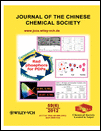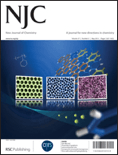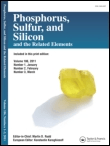
DOKLADY CHEMISTRY
Scope & Guideline
Advancing the frontiers of chemical knowledge.
Introduction
Aims and Scopes
- Chemical Synthesis and Characterization:
The journal publishes studies on the synthesis of new chemical compounds, including organic molecules, polymers, and inorganic materials, along with detailed characterization methods such as spectroscopy, crystallography, and microscopy. - Biological and Medicinal Chemistry:
Research focusing on the biological evaluation of new compounds, particularly their antimicrobial, antiviral, and anticancer activities, is a prominent area, reflecting the journal's commitment to the intersection of chemistry and health sciences. - Materials Science and Nanotechnology:
DOKLADY CHEMISTRY includes contributions related to the development and application of advanced materials, including nanomaterials and composites, highlighting their structural, mechanical, and functional properties. - Catalysis and Reaction Mechanisms:
The journal emphasizes studies on catalytic processes, including the development of new catalysts and investigations into reaction mechanisms, which are crucial for advancing chemical synthesis and industrial applications. - Environmental and Green Chemistry:
Research addressing environmental challenges, such as the synthesis of eco-friendly materials and processes, as well as studies on waste utilization and pollutant degradation, are integral to the journal's scope.
Trending and Emerging
- Sustainable and Green Chemistry:
Recent publications increasingly emphasize sustainable practices and the development of green chemistry methodologies, reflecting a global push towards environmentally friendly chemical processes. - Advanced Nanomaterials and Applications:
There is a growing trend in the exploration of nanomaterials, particularly their synthesis and application in fields such as catalysis, energy storage, and biomedical uses, indicating a strong interest in nanotechnology. - Interdisciplinary Approaches to Chemical Research:
Emerging themes highlight the integration of chemistry with other disciplines, such as biology, materials science, and environmental science, promoting collaborative research that addresses complex scientific problems. - Biochemical and Medicinal Applications:
The journal is increasingly publishing studies that explore the biochemical properties and potential medicinal applications of new compounds, particularly in the context of drug discovery and development. - Catalytic Innovations for Energy Solutions:
Research focusing on novel catalytic processes aimed at energy production, such as hydrogen generation and carbon capture, has gained traction, reflecting the urgency of addressing energy and climate challenges.
Declining or Waning
- Classical Organic Synthesis Techniques:
There has been a noticeable decrease in publications focusing solely on traditional organic synthesis methods. Researchers are increasingly favoring innovative and greener approaches, reducing the emphasis on classical techniques. - Inorganic Chemistry without Application Context:
Papers dealing with purely theoretical aspects of inorganic chemistry, without a clear application or relevance to current technological or environmental issues, appear to be less frequent, reflecting a broader trend towards practical applications. - Conventional Polymer Chemistry:
The journal has seen a reduction in studies centered on conventional polymer synthesis, as interest shifts towards more advanced materials and methods, such as biopolymers and smart materials.
Similar Journals

DOKLADY PHYSICAL CHEMISTRY
Elevating Knowledge in Physical and Theoretical ChemistryDOKLADY PHYSICAL CHEMISTRY is a prominent peer-reviewed journal published by MAIK NAUKA/INTERPERIODICA/SPRINGER, focusing on advancements and research in the field of Physical and Theoretical Chemistry. With the ISSN 0012-5016 and E-ISSN 1608-3121, this journal serves as a vital platform for researchers and practitioners to disseminate their findings and insights from 1996 to the present. Despite its current Q4 ranking in the 2023 category of Physical and Theoretical Chemistry, the journal has shown significant potential for visibility and engagement within the academic community, ranking #149 out of 189 in its respective field according to Scopus metrics, highlighting its dedicated readership. While the journal is not open access, it remains an essential resource for those seeking in-depth research articles, reviews, and commentary within this dynamic discipline. As the field continues to evolve, DOKLADY PHYSICAL CHEMISTRY plays a crucial role in fostering scientific dialogue and collaboration among researchers, professionals, and students worldwide.

JOURNAL OF THE CHINESE CHEMICAL SOCIETY
Advancing Chemistry Through Innovative ResearchJOURNAL OF THE CHINESE CHEMICAL SOCIETY, published by WILEY-V C H VERLAG GMBH, is a vital resource in the field of chemistry, focusing on a broad array of topics pertinent to general chemistry and its advancing sub-disciplines. Established in 1954 and running through 2024, this journal serves as a significant platform for the dissemination of high-quality research, showcasing innovative findings and developments within the chemical sciences. With its Q3 category ranking and positioning at Rank #203 in General Chemistry per Scopus, it reflects the journal's commitment to research excellence and impact. While not an open-access publication, it ensures accessibility to a global audience, making it an essential tool for researchers, professionals, and students alike seeking to stay informed and engaged in the evolving landscape of chemistry.

REVUE ROUMAINE DE CHIMIE
Catalyzing Innovation in the Realm of ChemistryREVUE ROUMAINE DE CHIMIE is a distinguished academic journal in the field of chemistry, published by EDITURA ACAD ROMANE in Romania. With an ISSN of 0035-3930, this journal has been a valuable platform for disseminating original research and insights in the diverse realm of chemistry since its inception. The journal currently operates under a competitive tier, categorized in Q4 for miscellaneous chemistry fields, as reflected in its Scopus ranking of #348 out of 408, placing it within the 14th percentile. Aiming to foster scientific discourse and innovation, the REVUE ROUMAINE DE CHIMIE provides a repository of knowledge that is crucial for researchers, professionals, and students eager to advance their understanding and contribute to the global chemistry community. By bridging local and international research initiatives, this journal plays an essential role in enhancing the visibility of Romanian scientific contributions on the world stage.

Journal of the Iranian Chemical Society
Advancing Chemistry Through Innovative ResearchThe Journal of the Iranian Chemical Society, published by SPRINGER, is a prominent academic journal dedicated to advancing the field of chemistry. With an ISSN of 1735-207X and an E-ISSN of 1735-2428, this quarterly journal has been contributing valuable research from 2006 to 2024. Situated in Germany, it serves as a vital platform for chemists and researchers to disseminate their findings, particularly within the miscellaneous chemistry category, where it ranks in the Q3 quartile for 2023. Despite its current lack of open access options, the journal maintains a solid presence in the academic community, evidenced by its Scopus ranking of #165 out of 408 in general chemistry and a commendable 59th percentile. The journal's objective aims to foster innovation and collaboration in chemical research, making it an essential resource for professionals and students keen on pioneering developments in the field. As a subscriber, you will gain insights into cutting-edge research that drives the future of chemistry.

NEW JOURNAL OF CHEMISTRY
Fostering Excellence in Chemical ResearchNEW JOURNAL OF CHEMISTRY, published by the prestigious Royal Society of Chemistry, serves as a vital platform for the dissemination of research in the dynamic fields of chemistry, catalysis, and materials science. With an impressive ISSN of 1144-0546, this journal boasts a rich history, having been established in 1996, and is set to continue its impactful publication through 2024. The journal is recognized in several categories, achieving a Q2 ranking in both chemistry and materials chemistry, and a Q3 rank in catalysis, reflecting its significance within these disciplines. Researchers will find it particularly noteworthy that the journal holds an esteemed position in the Scopus rankings, with a 65th percentile standing in general chemistry. Though it currently operates on a subscription model, its commitment to advancing the frontiers of chemistry makes it an essential resource for academics, professionals, and students seeking to keep abreast of the latest advancements and innovative methodologies in their fields.

JOURNAL OF HETEROCYCLIC CHEMISTRY
Advancing Knowledge in Organic ChemistryJournal of Heterocyclic Chemistry, published by Wiley, stands as a key resource in the field of organic chemistry, offering in-depth research articles and insights spanning from 1966 to 2024. With its strong Scopus ranking of #83 out of 211 in the Organic Chemistry category, placing it in the 60th percentile, the journal maintains its significance and relevance within the academic community. Although it does not currently offer open access options, it provides extensive coverage of heterocyclic compounds, which are vital to various applications in pharmaceuticals and material sciences. The journal's commitment to high-quality research is further reflected in its classification as Q3 in the 2023 quartiles for Organic Chemistry. Researchers, professionals, and students alike will find valuable contributions to the intricate studies of heterocycles, enhancing their understanding and exploration of this fascinating area of chemistry.

JOURNAL OF THE CHILEAN CHEMICAL SOCIETY
Catalyzing Knowledge for a Sustainable Future.The Journal of the Chilean Chemical Society, published by the Sociedad Chilena de Química, serves as a premier platform for disseminating significant research findings in the field of Chemistry. With an ISSN of 0717-9707, this journal has established its presence since 2003, providing open access to a diverse range of studies and advancements in this vital scientific domain. It currently holds a Q3 category ranking in Chemistry (miscellaneous) and ranks 196 out of 408 in the general chemistry category on Scopus, indicating its valuable contributions to the field. Through the journal, researchers, professionals, and students are encouraged to engage with cutting-edge research and foster collaboration among the scientific community in Chile and beyond. The society's commitment to excellence ensures that articles published reflect high-quality research, underpinning the journal’s role in shaping knowledge and innovation in chemistry.

Chemical Methodologies
Pioneering the Future of Chemical ScienceWelcome to Chemical Methodologies, a premier journal published by SAMI PUBLISHING CO-SPC, dedicated to advancing the field of chemistry through innovative research and methodologies. With an ISSN of 2645-7776 and an E-ISSN of 2588-4344, this journal provides a vital platform for researchers and scholars to share their findings in areas encompassing physical, theoretical, and organic chemistry. Despite its initial HIndex and quartile rankings still being established, the journal's evolving impact within the academic landscape is underscored by its Scopus Ranks, which place it in the 35th percentile for physical and theoretical chemistry and the 33rd percentile for organic chemistry. Since its inception in 2022, and continuing through 2024, Chemical Methodologies aims to foster collaboration and knowledge dissemination among academics and practitioners alike, bridging theoretical concepts and practical applications. This open-access platform enhances accessibility for researchers and students worldwide, ensuring that groundbreaking contributions to chemical science reach a broad audience.

Molbank is an open-access journal published by MDPI, dedicated to the fields of Biochemistry, Organic Chemistry, and Physical and Theoretical Chemistry. Established in 2002, this journal has served as a vital platform for the dissemination of research findings, where researchers and professionals share original articles focusing on molecular chemistry, synthesis, and related studies. With a commitment to open access, Molbank enables global access to scientific knowledge, fostering collaboration and innovation among scientists. While currently categorized in the fourth quartile for its field rankings, it provides a unique opportunity for emerging scholars to contribute to and engage with the scientific community. The journal is based in Switzerland, operating from its office at ST ALBAN-ANLAGE 66, CH-4052 BASEL, SWITZERLAND, and continues to attract submissions until 2024. Researchers, students, and professionals looking to expand their knowledge and participate in the dialogue of current molecular chemistry can benefit significantly from engaging with the content published in Molbank.

PHOSPHORUS SULFUR AND SILICON AND THE RELATED ELEMENTS
Unlocking the Secrets of Key Chemical ElementsPHOSPHORUS SULFUR AND SILICON AND THE RELATED ELEMENTS, published by Taylor & Francis Ltd, is a distinguished journal dedicated to advancing knowledge in the fields of Biochemistry, Inorganic Chemistry, and Organic Chemistry. Established in 1989, the journal has carved a niche in the scientific community by offering a platform for the publication of innovative research that explores the chemistry and applications of phosphorus, sulfur, silicon, and related elements. With an ISSN of 1042-6507 and an E-ISSN of 1563-5325, this journal provides access to valuable insights, albeit without open access options. Despite being positioned in the fourth quartile of its categories (Q4), it remains an essential resource for researchers, professionals, and students seeking to expand their understanding of these pivotal elements and their interactions. With a publishing horizon extending to 2024, the journal invites contributions aimed at pushing the boundaries of chemistry and fostering interdisciplinary dialogue.